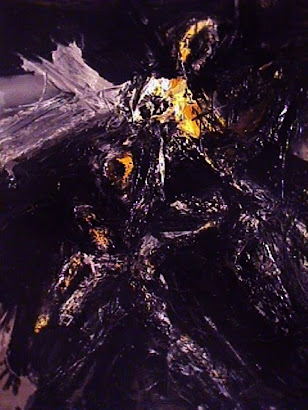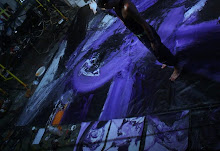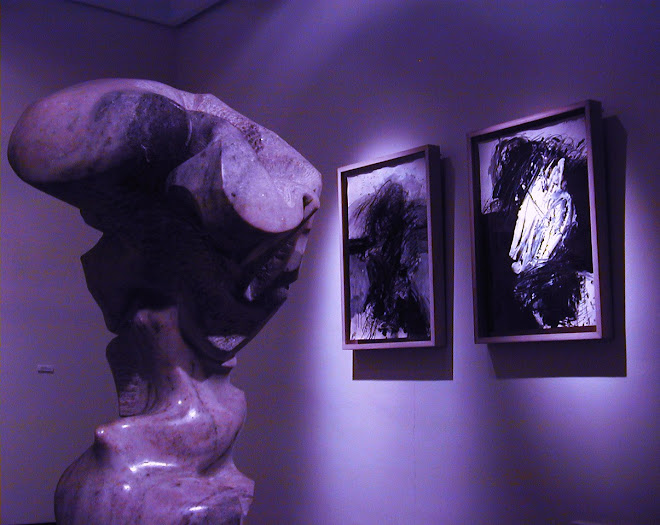.
.
.
Alfredo Arreguín’s Portraits of Memory and IdentityOne of the first questions one needs to address when writing about the Mexico-born, American artist Alfredo Arreguín is, what language to use? This question encapsulates some of the central issues of Arreguín’s works: their pluricultural references, their peculiar form of hibridity, the cultural mixes present on his canvases, and the richness that this artist brings to the American art scene. I decided to write in English, due to the inclusion of Arreguín’s works in the National Portrait Gallery's "Memory Portraits" exhibition. The choice of language does not mean, however, that I want to sidestep Arreguín’s Mexican roots, evident in some of the works selected. But it does mean that the language chosen is intended to stress Arreguín’s works as peculiarly American in the cultural references they present, in the spaces they depict, and in his style, all topics which are ultimately related to the issue of identity.
I propose Arreguín’s art blends together several diverse cultures, giving rise to something different and new as it masterfully conjugates the relationships between cultural diversity and cultural differences. These relationships that are not as peaceful as it is commonly assumed. There is a prevalent belief, especially in democratic societies, that cultural diversity is a good thing in and of itself. But the danger in this apparent universalism and acceptance of diverse cultures is that it masks ethnocentric norms and values. After all, in order to foster the coexistence of other cultures, democratic societies need to assume a privileged position from which to accommodate them. Such an assumption may sometimes be mistaken, since different cultures set among themselves an incommensurability, a non-common ground, that essentially separates them from one another. The lack of a common ground does not mean, however, that cultures cannot communicate. Cultures are not only separate, but also similar, albeit not in their content, but as signifying and symbolic activities. As such, they can be translated in order to make them understandable to outsiders. Out of the ideas of cultural diversity, difference, and translation, which deny the essentialism of a prior or originary culture, Homi Bhabha derives the notion that all cultures are continually in a process of hybridity. The importance of hybridity lays in the possibility of enabling other positions to emerge, giving rise to something different, new and perhaps unrecognizable, a new area of negotiation of meaning and representation. In our case, Arreguín’s work presents the cultural hybridity Bhabha refers to, opening up a fruitful space from where to look at the issues of cultural diversity present in his art.
In the “Preface” in Lauro Flores’ volume on Arreguín, the American poet Tess Gallagher says that “Arreguín’s patterns are taken from colonial Mexican art, Baroque church facades, decorative pre-Columbian art, animal and floral motifs of ceramic work from Tlaquepaque, but perhaps more directly from the crafts of Michoacán and Guerrero” (xx). She adds to this Mexican-related list, Islamic architecture, Indian Tantric painting, and Far Eastern images. The relationships she establishes between Arreguín’s work and those sources are a good first step to trace the images’ origins in art-historical terms. To those influences, I want to add others that, perhaps because they may seem obvious, are not readily cited. After his residence in Guerrero, Mexico, Arreguín returned to Mexico City where he saw, and I presume was deeply affected by, Diego Rivera’s murals, which Rivera had painted at the Escuela Nacional Preparatoria, in the Colegio de San Indefonso, in the 1920s. It is almost certain that at the time, in addition to Rivera’s murals, Arreguín also became familiar with Frida Kahlo’s work. To Rivera’s and Kahlo’s images present in Arreguín’s art we could also add others not based in the artist’s “ethnic” origins, such as those related to the African population living in Mexico, and represented by Arreguín as a beautiful rendition of a Madona Afro Latina (1989). In fact, Arreguín’s works are not just the result of his “blood”, his ethnic origins, or his birth place, but, and more importantly, they are closely related also to the visual arts from the United States, the country where he studied and where he developed his mature style. Undoubtedly, memories and especially “Memory Portraits” do play an important role in Arreguin’s works. His childhood and living close to Mexico’s jungles in San Luis de la Loma indeed contributed to the painter’s baroque and busy vision. But there are other “memories” present in his work, such as Abstract Expressionism, Pop and Conceptual Art, and Minimalism, and they come from America, not from América. Arreguín’s works selected for this exhibit fully represent the portraits, of course, but they also present images related to the spaces of Mexico and the border, rendered in a style that comes mainly from the United States.
In terms of style, Arreguín’s trajectory has been complex and rich. After finishing his studies at the University of Washington in 1969, he painted Emerald Island in 1970, a work that has been identified as the first American Pattern Painting. Even though at first sight, Emerald Island seems to be abstract, just about decorative patterns, under closer scrutiny it reveals shapes and figures that are almost recognizable as if they were perhaps an early antecedent of a semi-abstract portrait. The ambiguity between abstraction and figuration and the tension it creates characterizes the style of Arreguín’s mature work, providing a link to other American artists, such as Ross Bleckner and Philip Taaffe. Moreover, I perceive in his obsessive visual patterns, in his doodling with color, similarities with outsider art, Adolf Wölfli’s in particular, and with artists who, through “doodling,” create complex portraits full of meaning and emotional impact, such as Giuseppe Arcimboldo (1530-1593) or Chuck Close. In fact, some of Arreguín’s portraits of the writer Raymond Carver, such as Ray’s Ghost Fish, (1994) (Flores, 144) or Mi amigo Ray (Flores, xix) (2001), can be described as Chuck Close meets M. C. Escher’s visual transformations. In sum, Arreguín’s cultural references, spaces and style can clearly be seen in his works included in “Memory Portraits.”
Works
Since Diego Rivera and Frida Kahlo were a constant source of inspiration and visual references for Arreguín since he was in elementary school, it was only fitting that he would depict both Mexican cultural icons in his portrait series. Lauro Flores and others have extensively analyzed Kahlo’s figure in Arreguín’s art, and I will not repeat here what they have said, but I do want to call attention to the double image of Kahlo in the couple’s portrait, as if the image on the wall was Arreguín’s response to Kahlo’s own Self-Portrait as a Tehuana (Diego on My Mind) 1943 painting. While in this work Kahlo presented Rivera’s image within her own, Arreguín showcased her twice in his portrait, once as a person standing by Rivera’s side, the other as a face within the portrait, looking at both, Rivera and herself, from the privileged space of the wall. One can indeed think of Kahlo in Arreguín’s mind, even when painting Rivera.
Kahlo’s face, this time alone, is the subject of "Kahlo de Coyoacan," which includes in its title a reference to the location of her museum in the “colonia” near Mexico City. The portrait also has some of the visual themes that accompany several of Kahlo’s self portraits, such as birds and nature, but purged, as Flores notes, of tragedy and self pity. In this painting Arreguín adds to the jungle and natural references a mysterious hand, close to Frida’s ear (the child she lost? a double “portrait”? just an earring?) which contributes a touch of ambiguity and mystery to the whole piece.
Another Mexican icon is the revolutionary hero Emiliano Zapata (1879-1919). Although killed early in life, he has been a permanent presence in Mexican culture and politics, extending his appeal to the present Zapatista movement of Chiapas, where he has been presented as a quasi-religious icon. Arreguín’s portrait is part of a series he has been painting since the 1990s and which includes works such as Zapata’s Stables, from 1993. To the format of this painting, in Zapata's Messenger Arreguín adds precisely a messenger, a crow, which can be seen as a reference to Zapata’s untimely dead and also to the history of the Mexican Revolution as a whole.
Zapata is present once again in The Return to Aztlan. In this painting Arreguín has included, as he has said, “our heroes of the Independence of Mexico, Hidalgo and Morelos. Below, Hidalgo is Cesar Chavez, the leader of the Farm Workers, in the Center, Emiliano Zapata, and to his right, Dolores Huerta, also of the Farm Workers in this country. On the right is the image of La Virgen de Guadalupe, the brown Madonna that has accompanied many revolutionaries in battle” (letter to the author). As we can see, these cultural icons are not just Mexican, but form part of what some authors have called the “Gran Mexico” which, as cultural notion, refers to Mexico but also to the United States’ southern borderlands. The
United Farm Workers’s movement and its historic role in forming a Chicano consciousness in the 1960s are integral part of that region and of the history of the United States as well. The Farm Workers movement’s logo, a black eagle, is present in the upper part of Arreguín’s work, while the painting’s title refers to Aztlán, the mythical homeland of the Aztecs / Mexica from where the Chicano movement took its name. With the use of the black eagle, Chávez, and Aztlán, Arreguín adds complex layers of cultural and historical references to his oeuvre, which embraces this time the hybrid culture of the borderlands and its political, social, and cultural richness.
Similar references are present in Good Harvest (Cesar Chavez, Homage), this time looking into the future, not just the past. As Arreguín said in a letter to the author, “In the painting [Good Harvest] the child on the left, with the candle signifies the future generations of Mexican-Americans or Chicano.” Besides The Return to Aztlan and Good Harvest Chavez, the little boy, the black eagle logo, the Virgen, and the butterflies are also present in a previous work, Sal Si Puedes II, from 1993, as if The Return… and Good Harvest were continuations of that painting. In these works, and throughout Arreguín’s oeuvre really, the figure of the Madonna refers not just to Catholic beliefs, but to the spiritual ingredients of the cultures and identities represented in these magnificent portraits, Mexican, Mexican-American, and American; American, that is, in a continental scale.
As presented in the works selected for the “Memory Portraits” exhibit, I believe the true identity of Arreguín’a art belongs to the hybrid space articulated by Bhabha and created, as in all cultures, through mixtures and encounters that give rise to something different, new, unrecognizable, rich, and which Arreguín has wonderfully rendered in this series of portraits.
Works Cited
Bhabha, Homi. “The Third Space: Interview with Homi Bhabha.” Rutherford, Jonathan, ed. Identity. Community, Culture, Difference. London: Lawrence & Wishart, 1990.
Flores, Lauro. Alfredo Arreguín. Patterns of Dreams and Nature / Diseños, sueños y naturaleza. Seattle: University of Washington Press / Bellevue: Bellevue Arts Museum / Zamora: El Colegio de Michoacán, A. C., 2002. Jacob Lawrence Series on American Artists.
Gustavo Fares, Ph.D.
Visual artist and critic
Professor at Lawrence University
501 East College Avenue
P.O. Box 599
Appleton, WI 54912-0599
Phone: (920) 832-6691
Fax: (920) 832-6944
faresg@lawrence.edu
http://www.lawrence.edu/fast/faresg/art(*) N. EQ-GC :
Los críticos de arte lo han considerado uno de los mayores exponentes de la “pintura pattern”, aunque su obra conduce mucho más allá del “ molde “ , del “patrón” y del estereotipo. Se trata de mensajes con colores, sabores… es ritmo, es unión con la tierra, es identificarse con sus orígenes , conlleva un colectivo.
▲






















































